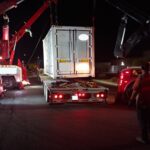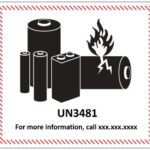Before we begin…
All of the following is based on the Hazardous Materials Regulations (HMR) of the Pipeline and Hazardous Materials Safety Administration within the U.S. Department of Transportation (USDOT/PHMSA).
Question (10.20.20):
You seem to have the most info and the most accurate info regarding highway transportation of hazmat. Recently I hauled this “modular power unit” from NM to NY. At the delivery point the job super asked why it wasn’t placarded, I told him I wasn’t tendered the load as hazmat, so I had no idea. He told me the unit was a battery backup for GE and contained 50,000 lbs of lithium ion batteries. Is that considered hazmat and was it supposed to be marked or placarded?
|
Daniels Training Services, Inc. 815.821.1550 |
Answer (10.20.20):
Thank you for the compliment. Good question. The answer depends on many factors. See below.
- This table indicates the regulatory thresholds for lithium battery “size”. It is necessary for the classification and transport of lithium batteries.
| Status | Lithium Ion Battery (Watt-hour (Wh) Rating) | Lithium Metal Battery (Lithium Content (g)) |
||
|---|---|---|---|---|
| Battery | Cell | Battery | Cell | |
| Subject to "smaller battery exception" | Does not exceed 100 Wh | Does not exceed 20 Wh | Does not exceed 2 g | Does not exceed 1 g |
| Subject to full regulation | Exceeds 100 Wh | Exceeds 20 Wh | Exceeds 2 g | Exceeds 1 g |
| Subject to "smaller battery exception" by highway or rail | Does not exceed 300 Wh | Does not exceed 60 Wh | Does not exceed 25 g | Does not exceed 5 g |
- If the lithium batteries met the criteria for “smaller” in the HMR i.e., less than 100 Watt/hour (Wh) for lithium ion or less than 2 grams of lithium metal for lithium metal battery, then it is (mostly) not subject to USDOT regulations when in transport. It would not be a “HazMat” load but each package containing a lithium battery would need to display the lithium battery mark. No other regulations would apply. Read: Classification of Lithium Batteries for Transportation in Commerce
- If the batteries were larger than indicated above (as I suspect they are), then they would be subject to full regulation as a “HazMat” shipment. However, even then it is not necessary to display placards on the vehicle.
Q: “Why is it not necessary to display placards on a vehicle transporting this quantity of lithium batteries?”
A: “Lithium batteries of all types, all configurations, and all quantities are a Class 9 Miscellaneous. The display of the Class 9 Miscellaneous placard is not required within the U.S. – though it remains an option.
Read: Is the CLASS 9 Placard Required?
- Further, since the vehicle is not required to display a placard, the driver is not required to have the HazMat endorsement on their CDL.
- However, if this is a fully-regulated HazMat shipment as I suspect, you should have been provided with a shipping paper describing the consignment and been given emergency response information and an emergency telephone. Also, you must receive HazMat Employee training.
- If you are able to provide more information about the batteries I can provide more specific information.
- At a minimum you should have HazMat Employee Training.
Please contact me with any other questions.
|
Contact me with any questions you may have about the transportation of lithium batteries by air, highway, vessel, or rail International and Domestic |
That did it!
The transportation of lithium batteries is essential and complicated. Make sure you comply with the Hazardous Materials Regulations of USDOT/PHMSA for any transportation to, from, or through the U.S.


